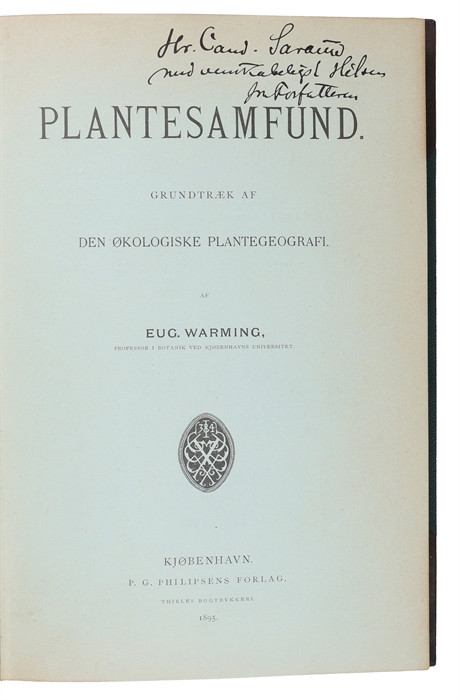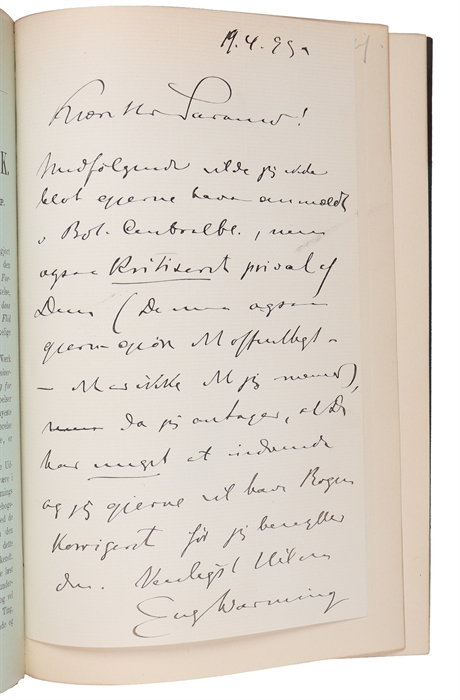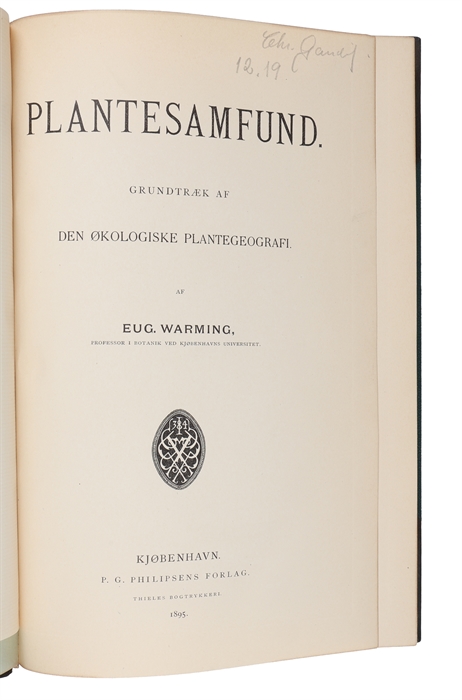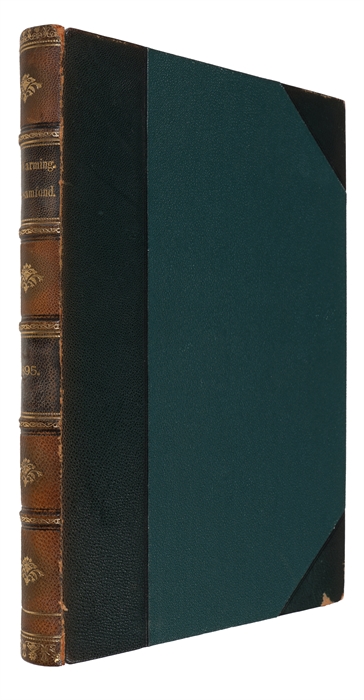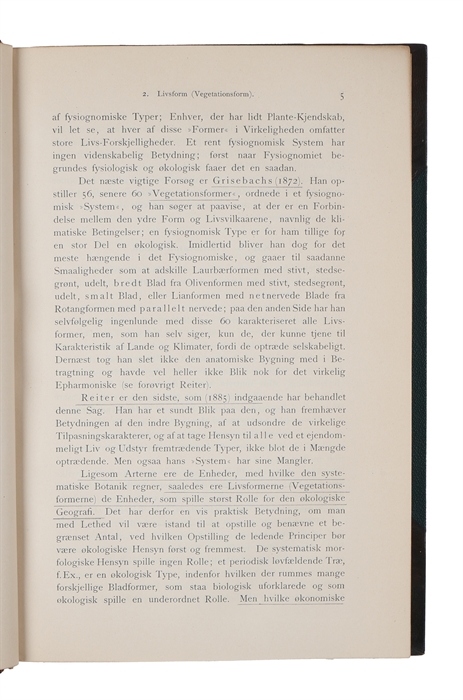FOUNDING PLANT ECOLOGY - PRESENTATION-COPY
WARMING, EUG.
Plantesamfund. Grundtræk af den økologiske Plantegeografi.
Kjøbenhavn, Philipsen, 1895.
8vo. Bound with the original printed front-wrapper in contemporary half calf with gilt lettering to spine. Front free end-paper with previous owner's name (G. Sarauw). With author's presentation inscription to title-page: "Hr. Cand. Sarauw / med venskabelig Hilsen / fra Forfatteren".
Withbound is a 15 line letter from Warming: "19.4.95 / Kære Hr. Sarauw / Medfølgende vilde jeg ikke / blot gjerne have / anmeldt i Bot. Centralblad., men ogsaa kritiseret privat af / Dem (De må også / gjerne gøre det offentligt / det er ikke det jeg mener) / da jeg antager, at De / har meget at indvende / og jeg gjerne vil have Bogen / korrigeret før jeg [?] den. Venligst Hilsen / Eug Warming". (i.e. English: ""19. 4. 1895 / Dear Mr. Sarauw / the enclosed I would not only wish to have reviewed in Botanisk Centralblad, but also privately criticized by you (you are of course also welcome to do so publicly—that’s not what I mean), since I assume that you have many objections and I would very much like to have the book corrected before I [?] it. Kind regards / Eug. Warming").
Light wear to extremities, otherwise a very nice and clean copy. VII, (1), 335 pp.
A magnificent presentation-copy of the first edition of this milestone in the history of ecology, being the first textbook of ecological plant geography ever published and the work that established ecology as a formal scientific discipline. The present copy is inscribed by Warming to G. Sarauw, a Danish-Swedish botanist and archaeologist known for his pioneering interdisciplinary work. Inserted between the front wrapper and the title-page is furthermore a 1-page autograph letter from letter from Warming to Sarauw asking him to criticize and help correct the work before it is published. The letter reveals Warming’s intellectual humility and his scientific approach of peer engagement prior to more formal discussions - not merely seeking publicity or endorsement, but genuinely inviting criticism from a respected peer. The recipient, Sarauw, was a fellow botanist trained in the natural sciences who would later gain fame for his archaeological work at Maglemose, but at the time he was a close colleague within the Danish scientific community. Warming’s ”Plantesamfund” established ecology as a formal scientific discipline on the interaction between organisms and their environment long before the term “ecology” gained general acceptance. The work summed up decades of Warming’s own field research in Brazil, Denmark and Greenland and articulated a structured and comparative approach to vegetation types, ecological adaptations and habitat conditions. Grouping of plants understood not merely taxonomically, but functionally and in relation to their environment, was groundbreaking, marking a decisive turn in botanical science and laying the groundwork for all modern ecology. “In "Plantesamfund" (1895) - (the work offered) - he formulated the program of his research: "To answer the question: Why each species has its own habit and habitat, why the species congregate to form definitive communities, and why these have a characteristic physiognomy.". In the late 19th century a new interest in nature and the complicated interplay between different species and types arose: “This interest in the influence of the environment on plants gave rise to the new field of ecology, pioneered by the Danish professor Eugen Warming (Warming 1895). Warming’s work had wide-reaching impact. British botanist Arthur Tansley was drawn to ecology after reading Plantesamfund (Warming 1895), commenting: “I well remember working through it with enthusiasm in 1898 and going out into the field to see how far one could match the plant communities Warming had described for Denmark in the English countryside. ….” Tansley would later state that: “Though the organisms may claim our prime interest, when we are trying to think fundamentally, we cannot separate them from their special environments, with which they form one physical system” (1935).” (Mabberly, A Cultural History of Plants in the Nineteenth Century, p99) The work was quickly translated into German, French, English Russian, and Polish, and especially the German translation from 1896 became immensely influential, especially in Britain and North America directly inspiring leading ecologists like Arthur Tansley, Henry Chandler Cowles and Frederic Clements. Even today, Warming’s work continues to be read and is widely regarded as the foundational text of the subject, often viewed as the “bible” of ecological science.
Biologist R. J. Goodland wrote in 1975: “If one individual can be singled out to be honoured as the founder of ecology, Warming should gain precedence”. (Goodland, R.J. The tropical origin of ecology: Eugen Warming’s jubilee.p. 240-245).
The book created an enormous sensation as a new attempt at grouping and characterizing the plant communities - a new phytogeographical term by which Warming meant a group of species forming a physiognomically well-defined unity, such as a meadow. In all essentials the species of a community are subject to the same external conditions arising from the ecological factors. These factors are of a fundamental importance to the ecology ofthe individual plant and the plant community. Considering water to be the most important factor, Warming divided plant communities into four types: hydrophytic, xerophytic, halophytic, and mesophytic." (DSB XIV, p. 181).
Order-nr.: 62375

